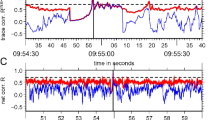Abstract
Waveform cross correlation is an efficient tool for detection and characterization of seismic signals. For the purposes of the Comprehensive Nuclear-Test-Ban Treaty, cross correlation can globally reduce the threshold of detection by 0.3 to 0.4 magnitude units. However, the technique critically depends on the availability of master events. In Part I of this paper, we have demonstrated that in seismically active regions the best master events (grand-masters) replicated over a regular grid allow improving the efficiency of signal detection and event finding. In aseismic areas, there are two approaches to populate the global grid of master events for the International Monitoring System: the replication of grand-masters and calculation of synthetic seismograms for master-events in the global grid nodes. The efficiency of synthetic templates depends on the accuracy of shape and amplitude predictions controlled by focal depth and mechanism, source function, velocity structure and attenuation along the master/station path. Here we test three focal mechanisms (explosion, thrust fault, and actual Harvard CMT solution for one of the April 11, 2012 Sumatra aftershocks) and two velocity structures (ak135 and CRUST 2.0). Sixteen synthetic master events were distributed over a 1° × 1° grid covering the zone of aftershocks. We built five cross correlation standard event lists (XSEL) and compared detections and events with those built using the real and grand master events as well as with the Reviewed Events Bulletin of the International Data Centre. The XSELs were built using an explosion source and ak135 and the reverse fault with isotropic radiation pattern to demonstrate the performance similar to that of the real and grand masters. Here we have proved quantitatively that it is possible to cover all aseismic areas with synthetic masters without significant loss in seismic monitoring capabilities based on cross correlation.
Similar content being viewed by others
References
Aki, K. and Richards, P.G., Quantitative Seismology: Theory and Methods, New York: Freeman, 2002, 2nd ed.
Bobrov, D.I., Kitov, I.O., Rozhkov, M.V., and Friberg, P., Towards global seismic monitoring of underground nuclear explosions using waveform cross correlation. Part I: Grand master events, Seism. Instrum., 2016, vol. 52, no. 1, pp. 43–59.
Bobrov, D., Khukhuudei, U., Kitov, I., Sitnikov, K., and Zerbo, L., Automated recovery of the 2012 Sumatera aftershock sequence using waveform cross correlation, J. Earth Sci. Eng., 2013, vol. 3, pp. 437–460.
Bobrov, D., Kitov, I., and Zerbo, L., Perspectives of crosscorrelation in seismic monitoring at the In-ternational Data Centre, Pure Appl. Geophys., 2014, vol. 171, nos. 3–5, pp. 439–468.
Carpenter, E.W., A quantitative evaluation of teleseismic explosion records, Proc. R. Soc., London Ser. A., 1966, vol. 290, pp. 396–407. Computer Programs in Seismology—Tutorials. http://wwweassluedu/eqc/eqc_cps/TUTORIAL/
Coyne, J., Bobrov, D., Bormann, P., Duran, E., Grenard, P., Haralabus, G., Kitov, I., and Starovoit, Yu., CTBTO: Goals, networks, data analysis and data availability, in New Manual of Seismological Practice Observatory, Bormann, P., Ed., 2012, Ch. 15. doi doi 10.2312/GFZ.NMSOP-2_ch15
Dreger D. TDMT_INV: Time Domain Seismic Moment Tensor INVersion, in vol. 81B of International Handbook of Earthquake and Engineering Seismology, Lee, W.H.K., Kanamori, H., Jennings, P.C., and Kisslinger, C., Eds., Academic Press, 2003, p. 1627. doi 10.1016/S0074-6142(03)80290-5
Gibbons, S.J. and Ringdal, F., The detection of low magnitude seismic events using array-based wave-form correlation, Geophys. J. Int., 2006, vol. 165, pp. 149–166.
Gibbons, S.J. and Ringdal, F., Seismic monitoring of the North Korea Nuclear Test Site using a multi-channel correlation detector, IEEE Trans. Geosci. Remote Sens., 2012, vol. 50, pp. 1897–1909.
Harris, D., Subspace Detectors: Theory (Lawrence Livermore National Laboratory, Internal Report UCRL-TR-222758), Lawrence Livermore National Laboratory, 2006.
Harris, D. and Dodge, D., An autonomous system of grouping events in a developing aftershock sequence, Bull. Seismol. Soc. Am., 2011, vol. 101, pp. 763–774.
Harris, D. and Paik, T., Subspace Detectors: Efficient Implementation (Lawrence Livermore National Laboratory, Technical Report UCRL-TR-223177), Lawrence Livermore National Laboratory, 2006.
Haskell, N.A., Radiation pattern of surface waves from point sources in a multi-layered medium, Bull. Seismol. Soc. Am., 1964, vol. 54, pp. 377–393.
Herrmann, R.B., Computer programs in seismology: An evolving tool for instruction and research, Seismol. Res. Lett., 2013, vol. 84, pp. 1081–1088. doi 10.1785/0220110096
Hudson, J.A., A Quantitative evaluation of seismic signals at teleseismic distances–I. Radiation from point sources, Geophys. J. R. Astron. Soc., 1969a, vol. 18, no. 3, pp. 233–239.
Hudson, J.A., A Quantitative evaluation of seismic signals at teleseismic distances–II: Body waves and surface waves from an extended source, Geophys. J. R. Astron. Soc., 1969b, vol. 18, no. 4, pp. 353–370.
Kværna, T., Ringdal, F., and Baadshaug, U., North Korea’s Nuclear Test: The capability for seismic monitoring of the North Korean Test Site, Seismol. Res. Lett., 2007, vol. 75, pp. 487–497.
Rodgers, A., Harris, D., and Pasyanos, M., A model-based signal processing approach to seismic monitoring, in Proceedings of 28th Seismic Research Review: Ground-Based Nuclear Explosion Monitoring Technologies: Orlando, FL, 2006, pp. 455–464.
Rozhkov, M., Bobrov, D., and Kitov, I., Synthetics vs. real waveforms from underground nuclear explosions as master templates for CTBT monitoring with cross-correlation, in 2013 Fall Meeting, AGU, San Francisco, CA, 2013, Abstract S21B-2403.
Schaff, D., Kim, W.-Y., and Richards, P.G., Seismological constraints on proposed low-yield nuclear testing in particular regions and time periods in the past, with comments on “Radionuclide evidence for low-yield nuclear testing in North Korea in April/May 2010” by Lars-Erik De Geer, Sci. Global Secur., 2012, vol. 20, pp. 155–171.
Author information
Authors and Affiliations
Corresponding author
Additional information
Original Russian Text © D.I. Bobrov, I.O. Kitov, M.V. Rozhkov, P. Friberg, 2015, published in Seismicheskie Pribory, 2015, Vol. 51, No. 3, pp. 22–46.
The article was translated by the authors.
About this article
Cite this article
Bobrov, D.I., Kitov, I.O., Rozhkov, M.V. et al. Towards global seismic monitoring of underground nuclear explosions using waveform cross correlation. Part II: Synthetic master events. Seism. Instr. 52, 207–223 (2016). https://doi.org/10.3103/S0747923916030038
Published:
Issue Date:
DOI: https://doi.org/10.3103/S0747923916030038




